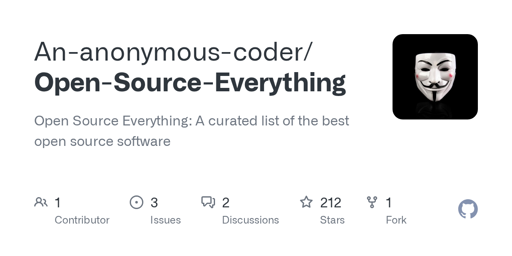We should not hold those ignorant to privacy accountable.They simply don’t know any better. Instead, we should only hold those actively opposing privacy accountable. We should try to educate those ignorant to privacy and show them the alternatives that exist. I bet if these content creators could switch without major loss (e.g. a major chunk of subscribers lost) most of them would be more than happy to.
The 8232 Project
I trust code more than politics.
- 19 Posts
- 15 Comments
It doesn’t yet pair with Gadgetbridge but I imagine it will at some point.
I was wondering this myself. Thank you for that useful information.

 4·26 days ago
4·26 days agoAre there any other examples of these privacy violations that aren’t common knowledge?
Here you go :)
I’m keen to know your angle.
Certainly! My threat model is mainly against mass surveillance, so this is my view: If there is a surveillance camera recording in a place where there is reasonable expectation of having no strangers, I am mostly fine with that. As you mentioned, if it is only recording your own private property where no strangers are meant to be, that is your business.
However, if it is recording a space where there is reason to expect strangers to be there without violating private property (e.g. stores, doorsteps, sidewalks) that is not ok. Simply, I should not be in the crossfire of your surveillance. I don’t know your intentions with the footage, and I don’t know who else may have access to it. It shouldn’t be my job to cover up just because you want to violate the public’s right to privacy.
You can see this post of mine about my views on the expectation of privacy in public. I made it about a year ago, and I haven’t read back over it, so it may be outdated or less refined than I’d prefer.
I am a huge advocate for the right to privacy, so I don’t have any surveillance cameras of my own. When I have friends over, I want to lead by example and make my space a private space for them too. Instead of funding more surveillance, we should be funding stronger locks and better deterrents that don’t violate human rights.
Ah, that explains it. Thank you! I apologize for the mistake.
(this was clearly MS Excel)
LibreOffice Calc, actually. You are correct about the color grading.
(or the author was lazy, since these are one of the defaults I believe)
I changed the conditional colors from the default to match the colors that LibreOffice uses for “Good”, “Neutral”, and “Bad”.
It’s odd that it says it’s licensed under
Creative Commons Attribution Share Alike 4.0 Internationalbut the actual license file is a different license.
I would advise against using surveillance cameras, because they violate others’ privacy. However, if you must, you can use hardware compatible with Frigate and upload it to whichever encrypted cloud server you wish.
Thanks! I’ve uploaded it!
If you feel one of the options offers something better than the one you currently use, you may consider switching. That’s the purpose of comparisons, after all!
“As seen on TV” does not imply privacy, it just implies a large advertising budget. These are software that market themselves as private (and are sometimes better than nothing at all) but may still be just as bad as software on the tip of the iceberg.
Do I even want to get there
Only you can answer that.
or is that limited to journalists who have entire states trying to unalive them?
Pretty much, but if you want to give up all technology, work for yourself, and fake your death, then more power to you!
Most Lemmy instances already work without JavaScript, but if you want a more friendly experience without JavaScript, you can browse using https://old.lemmy.world/

 0·1 year ago
0·1 year agoMany people’s threat models, like my own, are against mass surveillance. This falls under that category, even if it’s being handled responsibly. The issue is people have no way to opt out, and there is a lack of transparency about the use of facial recognition.



I appreciate their content, not their choices.